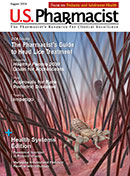Halle, Germany—Almost from the beginning of the COVID-19 pandemic, patients reported cases of persistent postinfection symptoms. The World Health Organization (WHO) now refers to new or persistent symptoms 12 weeks or more after a SARS-CoV-2 infection that cannot be explained by other causes as a post-COVID condition (PCC).
In a report in the Journal of Infection, researchers from University Medicine Halle in Germany and colleagues suggested that patients exhibited a lower post-COVID-19 risk after a second infection. The researchers advised that a fourth vaccine is strongly protective in some variants, cautioning that the risk of developing long COVID primarily depends on the virus variant.
Those conclusions were reached based on information from 109,707 participants in the German National Cohort (NAKO Gesundheitsstudie) on their self-reported health status related to postinfection symptoms. The survey took place in Autumn 2022.
When the survey was conducted, more than 80% of respondents had received three or more COVID-19 vaccinations and 60% reported that they had already been infected with SARS-CoV-2. In the online questionnaire, the researchers asked about 21 possible post-COVID-19 symptoms, such as physical exhaustion, cardiovascular problems, and cognitive impairment, with 35% of those who had been infected reporting at least one persistent post-COVID-19 symptom 4 to 12 months after infection. Of those who reported post-COVID-19 symptoms, a quarter reported nine or more of the symptoms.
Virus variants responsible for a particular infection were classified according to the periods of dominance in the national surveillance data in Germany. Infections until December 2020 were classified as Wildtype, between January and June 2021 as Alpha variant, between July and December 2021 as Delta variant, and from January 2022 as Omicron variant.
“As our analysis indicates, the virus variant has an impact on the risk of post-COVID-19 condition,” explained lead author Rafael Mikolajczyk, MD, MSC, director of the Institute of Medical Epidemiology, Biometrics and Informatics at the University Medicine Halle, adding, “The risk appears to decrease with the new virus variants. An Omicron infection was substantially less frequently associated with post-COVID-19 condition than earlier virus variants.”
The study found that COVID survivors who did not develop PCC after their first infection had a strongly reduced risk for PCC after their second infection (50%) and a temporary risk reduction, which waned over 9 months after the preceding infection. Within variants, meanwhile, the study team found no effect of the number of preceding vaccinations except a strong protection by the fourth vaccination compared with three vaccinations for the Omicron variant (odds ratio, 0.52; 95% CI, 0.45-0.61).
“Previous infections without PCC and a fourth vaccination were associated with a lower risk of PCC after a new infection, indicating diminished risk under hybrid immunity,” the authors concluded. “The two components of risk reduction after a preceding infection suggest different immunological mechanisms.”
Dr. Mikolajczyk added, “We also found a difference in case of repeated coronavirus infections. Those who did not develop post-COVID-19 condition after an infection and were infected again had a lower risk of post-COVID-19 condition than people who were infected for the first time.”
While the analysis shows that a fourth vaccination reduced the risk of PCC with Omicron, the number of vaccinations did not appear to have a direct influence on the development of PCCs.
“Even if this means that the previous vaccinations did not directly protect against post-COVID-19 condition, indirect protection can be assumed,” Dr. Mikolajczyk said. “This is because, according to the data currently available, those vaccinated had a lower probability of developing symptomatic coronavirus infections or suffering a severe infection, which in turn were associated with a higher risk of post-COVID-19 condition.”
The content contained in this article is for informational purposes only. The content is not intended to be a substitute for professional advice. Reliance on any information provided in this article is solely at your own risk.






